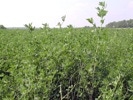May 2, 2010

The Central Minnesota Forage Council, Extension Staff and cooperating farmers and agribusiness people will be taking scissors cut alfalfa samples and PEAQ stick readings again in 2010.
Sites are being arranged in Stearns, Benton, Morrison, and Wright Counties as known at this point. The first samples will be taken today (Monday, May 3) at some sites and samples will be taken on Monday and Thursdays until the field is harvested.
Information will be shared by radio, website, and a call-in phone message. Questions about this project in Stearns, Benton and Morrison Counties can be referred to Extension Educator Dan Martens at 1-800-964-4929 or 968-5077 if a local call to Foley.
- Radio – Listen to KASM 1150 AM from Albany about 6:45 a.m. From Little Falls listen to KLTF 960 AM around 6:35 a.m. and 4:00 p.m. and WYRQ 92.1 about 10 a.m. New information will usually be provided on Tuesdays, Wednesdays, and Fridays. Information also might be used on Saturday.
- Online – The website is Minnesota Crop News at http://blog.lib.umn.edu/efans/cropnews. Look for "Hay Information" on the left side of the Crop News Page. This is the same place where an Extension summary is posted for the Sauk Centre Hay Auction.
- Phone report – A phone message report can be accessed by calling the Benton County Extension Office at 968-5077 if a local call to Foley or 1-800-964-4929. When the phone is answered, enter 5081.
For information about doing alfalfa scissors cut sampling or using PEAQ readings go to www.extension.umn.edu/forages. Look for "Alfalfa Harvest Alert Scissors Cut Program." There will be links to articles for using this tool with alfalfa and with alfalfa grass mix crops and a link to the Minnesota Crop News site where the central Minnesota harvest alert data is posted. If you'd like printed copies of articles that tell about using this in your fields, you're welcome to call Martens at 1-800-964-4929.
2010 Hay Crop Conditions – The alfalfa crop might be 2-3 weeks ahead of normal along with other things this spring. In checking a couple fields that will be used for this project southwest of Rice on April 23, tallest stems measured 12 to 14 inches. The scissor cut sampling project is usually started when the crop is around 16 inches tall.
Hay or haylage in feed bunk might be 15 to 25 RFV points lower than what fresh cut field samples test because of harvest and storage losses. So if the goal is to have feed in the bunk at 170 RFV, harvest might be started when fresh-cut samples or PEAQ readings are around 190. If several days are needed for cutting, growers might start harvest a few days sooner. PEAQ numbers are an estimate of the RFV in fresh cut samples based on the height and maturity of the tallest stems.
WEATHER: Yes, first crop hay harvest is often weather driven. In most years we don't have the privilege of picking a cutting day when the RFV, RFQ, PEAQ numbers read juuuuust right. It's might be more like we're looking for a chance to be in the ballpark when the weather window looks like we have an opportunity. Scissors cut sampling or PEAQ numbers can help us stay tuned to the crop as we are watching the weather. NDSU forage specialist have suggested as alfalfa gets toward 22 to 24 inches tall, we ought to be taking a close look at the weather and maturity of the crop for dairy quality hay. In the mean time we hope to avoid any severe frost and the moisture needed to keep the crop growing.
- By Dan Martens, U-M Extension
You May Also Like




